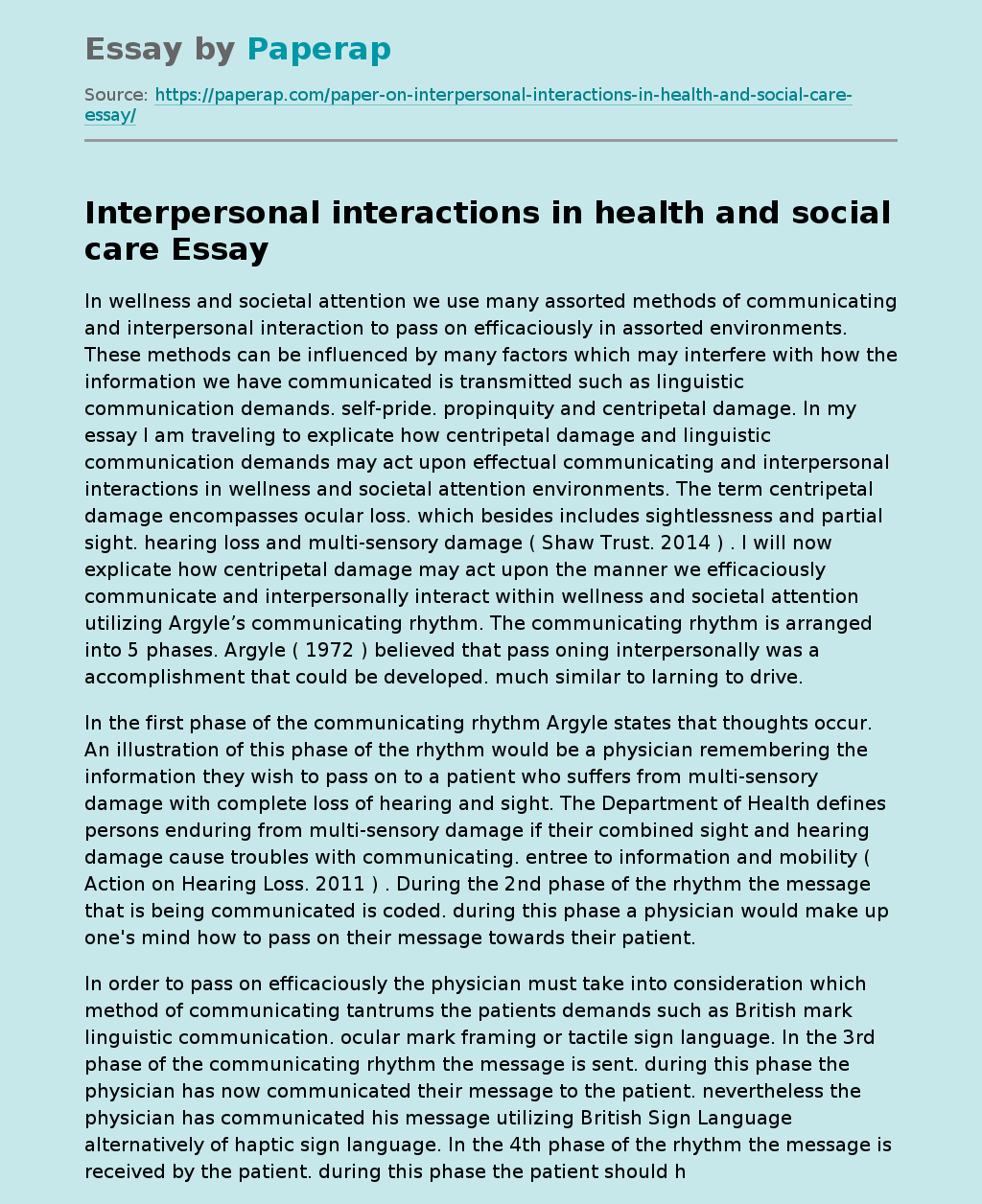Interpersonal Interactions in Health and Social Care
In wellness and societal attention we use many assorted methods of communicating and interpersonal interaction to pass on efficaciously in assorted environments. These methods can be influenced by many factors which may interfere with how the information we have communicated is transmitted such as linguistic communication demands. self-pride. propinquity and centripetal damage.
In my essay I am traveling to explicate how centripetal damage and linguistic communication demands may act upon effectual communicating and interpersonal interactions in wellness and societal attention environments.
The term centripetal damage encompasses ocular loss. which besides includes sightlessness and partial sight. hearing loss and multi-sensory damage ( Shaw Trust. 2014 ) .
I will now explicate how centripetal damage may act upon the manner we efficaciously communicate and interpersonally interact within wellness and societal attention utilizing Argyle’s communicating rhythm. The communicating rhythm is arranged into 5 phases. Argyle ( 1972 ) believed that pass oning interpersonally was a accomplishment that could be developed. much similar to larning to drive.
In the first phase of the communicating rhythm Argyle states that thoughts occur.
An illustration of this phase of the rhythm would be a physician remembering the information they wish to pass on to a patient who suffers from multi-sensory damage with complete loss of hearing and sight. The Department of Health defines persons enduring from multi-sensory damage if their combined sight and hearing damage cause troubles with communicating. entree to information and mobility ( Action on Hearing Loss. 2011 ) . During the 2nd phase of the rhythm the message that is being communicated is coded. during this phase a physician would make up one’s mind how to pass on their message towards their patient.
In order to pass on efficaciously the physician must take into consideration which method of communicating tantrums the patients demands such as British mark linguistic communication. ocular mark framing or tactile sign language. In the 3rd phase of the communicating rhythm the message is sent. during this phase the physician has now communicated their message to the patient. nevertheless the physician has communicated his message utilizing British Sign Language alternatively of haptic sign language.
In the 4th phase of the rhythm the message is received by the patient. during this phase the patient should hold successfully received the information that the physician has communicated to them nevertheless the patient has non received the message as she has lost a complete loss of sight and hence can non visually see the marks the physician is subscribing.
During the fifth and concluding phase the message is decoded. Agyle theory suggests that during this phase the information has now been received and understood and the rhythm will now reiterate. This phase of the rhythm is dependent on if the individual presenting the message has used the correct and appropriate signifier of communicating based on the persons demands and the fortunes. nevertheless this is where the communicating rhythm has been unsuccessful due to the incorrect pick of method of communicating. Another common factor which may act upon the manner we efficaciously communicate and interact with people within wellness and societal attention is the linguistic communication needs of the persons.
The linguistic communication needs of an person will be based upon many factors. a common linguistic communication demand may include an person who speaks English as a 2nd linguistic communication traveling to the United Kingdom. the demands of the person such as the usage of an translator will depend on how fluid the person is in talking English. Using Tuckman’s theory of group formation I will explicate how linguistic communication needs can impact the manner we efficaciously communicate and interpersonally interact in wellness and societal attention environments.
Tuckmans theory of group formation is arranged into 4 phases. these phases are known as forming. ramping. norming and acting. During the forming phase. the group of people are merely acquiring to cognize each other. for illustration in relation to wellness and societal attention. this would be the phase where a group of freshly employed pupil nurses run into the squad they will be working with. During the storming phase.
Tuckman ( 1965 ) explains how the group of people are ill-defined about each-others functions within the group and the purposes of working together. this is the phase where the freshly formed group of pupil nurses would be seeking to pass on verbally and nonverbally with each other in order to detect their functions. strengths and failings within the group. During this phase. the group of persons would be inquiring inquiries about each other and measuring their functions within the group.
Third is the norming phase. during this phase the group of people develop a shared apprehension of what each-others functions are and portion a common purpose. during this phase one person in the squad approaches the others and state them he is a foreign exchange pupil and has merely been talking English for the past 5 old ages. therefore he is still seeking to understand the different idioms around him.
The pupil nurses may get down to inquire and discourse with the person about the extent of his cognition in talking English. During this phase the persons will besides understand and be able to place countries of failing in talking English and be able to accommodate their methods of pass oning with the person in order to run into these demands.
Any specific linguistic communication demands of an person should be met instantly when pass oning in order to come on through to the concluding phase of Tuckman’s theory. the acting phase. During this phase the group of persons are now working together efficaciously as a squad. for illustration during this phase the pupil nurses are now able to run into the linguistic communication needs of the foreign exchange pupil and can go on to work as a progressive squad.
Interpersonal Interactions in Health and Social Care. (2017, Jul 28). Retrieved from https://paperap.com/paper-on-interpersonal-interactions-in-health-and-social-care-essay/

